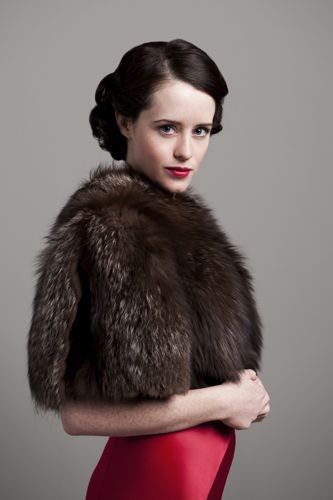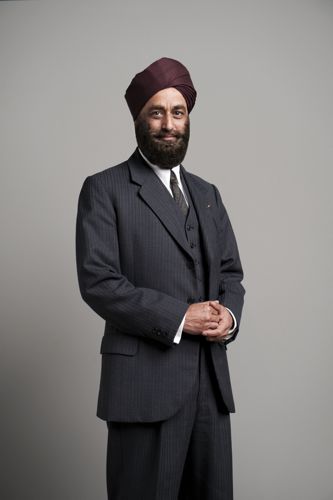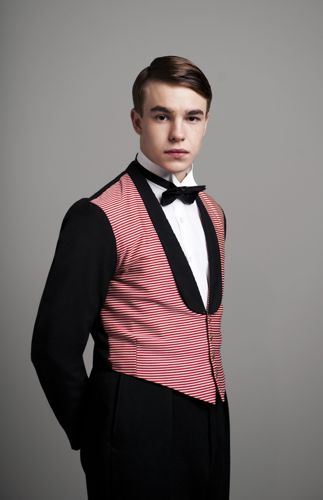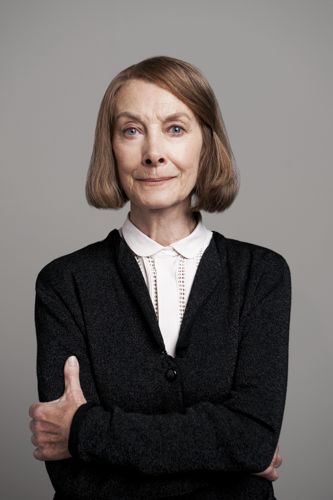
“AT first we thought that was a bit of a bore, quite frankly.
“As it happens, I think they’ve laid out the ground very nicely for us.”
Dame Eileen Atkins speaking at the British Film Institute in London last night about Downton Abbey.
Taking part in a panel Q&A following a screening of the first episode of BBC1’s revival of Upstairs Downstairs.
Originally broadcast on ITV over 68 episodes in five series between 1971 and 1975, the award-winning classic period drama covered the years from 1903 to 1930.
This new three-part BBC version begins six years on in 1936, back at London townhouse 165 Eaton Place, Belgravia.
Last night was the second time I’d seen the first hour-long episode, which is screened on Boxing Day.
With the second and third parts following on consecutive nights.
It’s an ensemble cast with Ed Stoppard as Sir Hallam Holland and Keeley Hawes as Lady Agnes Holland, a role she was born to play.
The Upstairs Downstairs v Downton Abbey debate is a bit of stuff and nonsense.
They are different shows and there’s no reason why you can’t watch and love them both.
Upstairs Downstairs 2010 begins as Foreign Office diplomat Sir Hallam and his wife Lady Agnes arrive back in Britain from Washington aboard a Cunard liner.
Returning to London to open up their new house in Eaton Place – in need of a bit of work.
“I’m so glad I booked the builders in advance,” says Lady Agnes.
There is much to enjoy in a series with a serious undercurrent.
Including Lady Agnes eating cod and chips, a monkey who likes thick cut marmalade and the bridge to the past provided by Rose Buck, played by original series co-creator Jean Marsh.
Anne Reid as new cook Clarice Thackeray steals every scene she appears in.
While Ellie Kendrick as orphaned housemaid Ivy Morris is simply bewitching.
As you would expect, there are dramatic developments for Lady Agnes later in the series.
With Claire Foy cast as her 20-year-old sister Lady Persie Towyn, never far from trouble.
Add in a reference to Jimmy Cagney’s 21st birthday party, and you’ve got what writer Heidi Thomas describes as “a glorious Christmas present” to the nation.
With hopes for more next year.
My story from last night’s event is below.
Followed by my edited highlights of that post-screening Q&A.

DOWNTON Abbey star Hugh Bonneville has called for a truce in a war of words with Upstairs Downstairs.
The actor, who plays the Earl of Grantham in the ITV1 hit, was upset at comments made by actress Jean Marsh, co-creator of the ‘rival’ costume drama.
A revival of TV classic Upstairs Downstairs, starring Keeley Hawes and Ed Stoppard, begins on BBC1 on Boxing Day.
Jean, 76, said she was “surprised” that Downton Abbey – telling a story of life below and upstairs – had appeared a few months before the return of her creation.
“It might be a co-incidence and I might be the Queen of Belgium,” added the actress, who also returns to the role of Rose Buck.
“Upstairs Downstairs had been in the works for about three years,” she told BBC1’s The One Show.
Co-creator Dame Eileen Atkins, 76, who plays Lady Holland in the new Upstairs Downstairs, was also taken aback when she heard of the plans for Downton Abbey.
“At first we thought that was a bit of a bore, quite frankly,” she said.
“As it happens, I think they’ve laid out the ground very nicely for us.”
Hugh, 47, wrote on Twitter: “I thought Jean Marsh was bigger than that – running down Downton while bigging up Upstairs?
“Downton never downed Up when upping Down.”
But he later urged Downton fans to watch the BBC show, adding: “The consensus seems to be that Ms Marsh needs a big huggle in the friendly chair.
“Last thing we need is a face-off at the Albert Memorial.”
Dame Eileen concluded: “It’s a very different take on it. So what was a little worry, I don’t think is a worry at all.”
While Jean added: “It’s set in the time that the first series was set. So it doesn’t clash with us.”
A second series of Downton Abbey, created by Oscar-winning Gosford Park writer Julian Fellowes, will be filmed in the New Year.
Edited highlights of the Q&A:
The panel:
L-R: Dame Eileen Atkins (Maud, Lady Holland), Jean Marsh (housekeeper Rose Buck), writer and executive producer Heidi Thomas, chairwoman Sue MacGregor, Adrian Scarborough (butler Mr Pritchard), Anne Reid (cook Mrs Thackeray) and Art Malik (secretary Mr Amanjit)
Eileen and Jean – you own the copyright of this whole idea? How did it come about?
Jean: “Well, it started in Eileen’s kitchen, in her flat. We talked about how we’d like to create something, maybe for us to do or just…we didn’t know what it would be, a film a book, a television series…I think we wanted a bit of independence. We didn’t just want to be hired. It slowly evolved that we would stick to something that we knew about, like our past, our parents.”
Eileen: “My father was an under-chauffeur. But it started really because I found a photograph of my mother on an outing from the bar of the Trocadero Theatre, where she was a barmaid, as well as doing a million other things. And we got intrigued. And we kept saying it would make a wonderful TV series. Then we watched The Forsyte Saga and we got so cross – the original. We started saying things like, ‘Yes, it’s all very well for them but who ironed that dress?’ And gradually we said, ‘Well, hang on a minute. We’ve both got parents who were in service. What about a series about being downstairs?’ And the original idea was just to be downstairs.”
Wasn’t the original title ‘Behind The Green Baize Door?’
Jean: “We dipped around with Behind The Green Baize Door, Below Stairs…we were only thinking of downstairs. But there’s no such thing, really, as Downstairs Upstairs. We realised that they have to serve somebody.”
Eileen: “We realised that they didn’t have a job unless you knew what was going on upstairs. So that’s what happened.”

Heidi – you had the difficult task of picking up something that a lot of viewers hold dear to their hearts. How did you approach it?
Heidi: “It was very dear to my heart. It was my favourite programme when I was growing up. I missed the first two series because I was too young. I was actually in bed when it was on. And then I watched series three, four and five. I didn’t miss a single episode of the iconic theatre when it got to the First World War. I just loved it. It was very important to me and I carried that love forward with it. I think it was very easy for me to wear the shoes of the fan, really, because I’m such a fan.
“What was interesting about it was going back and re-viewing because I then watched the whole series, all 68 episodes. And when I was a child, I found it profoundly educational. I loved the details about the war, women’s suffrage, the General Strike. I didn’t realise there was so much sex in it. It had all gone completely over my head. And so there was a whole new dimension of the series for me to digest.
“I was about 11 when I started watching it but my mother was always out, so the babysitter would let me stay up.”
You tend to concentrate on costume drama. Do you have lots of books and photographs and paintings and that sort of thing?
Heidi: “Obviously I have family photographs. My father’s mother was in service as a nursery maid and married the boss when his wife died and had several more children with him. So I’ve got a very similar background to Jean and Eileen, which I think has helped us all, hasn’t it?
“But I collect housekeeping encyclopaedias, cookery books, old magazines. What you would call ephemera, the kind of books that weren’t treasured at the time when they were published. But I think one woman’s magazine will tell you more about a woman’s experience in an era than three feet worth of sociological academic books. So I look at those first.”

Adrian has been on the stage of the National Theatre many times, quite often in 1930s-type plays. Do you slip into it?
Adrian: “I’d finished a play over the autumn called After The Dance, which is set in 1938 rather fortunately. So that sat very comfortably. I don’t know why it is. I seem to get employed in that era quite a lot. I obviously have a Thirties double chin or something. I don’t know why. It just sits very comfortably with me. I like the size of the waistband in the trousers.”
Are you going to continue the very interesting theme of saying you’ve got a grandparent who was in service?
Adrian: “No. My grandparent worked for the Co-op – with a horse and cart. He was a delivery man.”
Mr Pritchard, like a lot of butlers, is a bit of a snob?
Adrian: “I think he does have ideas above his station. I think at heart he’s very strong morally and a very fastidious person who’s very good at his job, ultimately. The wonderful thing about picking up one of Heidi’s scripts is that, actually, she does an awful lot of your work for you. And so much of that was already there and very clearly written into the script, that when I tried the shoes on, it just slipped in very easily and comfortably. I think he does have ideas above his station. But at heart he’s a very genuine, decent fellow….and I don’t want to spoil a storyline that might happen later on.”
Anne – your character had to be persuaded to join the household?
Anne: “Yes, they were very lucky to get me.” (laughter) “I was very happy at Virginia Water with the raincoat manufacturer. You think, ‘Do you want to play a cook?’ I don’t cook at all. So there’s a lot of acting going on. I’ve been looking things up on the internet. It was just great fun. When I saw the script and I read the first scenes and I saw this woman, I immediately wanted to play her. I wanted to grab her. There are lovely scenes – and the smoking. I gave up smoking a long time ago and, I tell you, it doesn’t leave you. I got really hooked on it. They are herbal cigarettes. But I love all that Thirties thing, when everybody was playing a love scene and blowing smoke in somebody’s face.”

Art Malik, you are a very interesting character as the secretary to Her Ladyship (Eileen Atkins), because you’re neither really upstairs or downstairs, in a way?
Art: “It’s great to play a part that is upstairs and downstairs and he’s welcomed in both worlds. For me, the difficulty was trying to find the Indian accent. The beard was Heidi’s demand. It was a caveat of accepting the job that I grew a beard. And I couldn’t. So we spent two hours every morning having it put on. We had Sikh advisors, because we didn’t want to upset anybody – the turban was put on every day.”
We’ve seen the trailer and can see that Sir Oswald Mosley and fascism are going to come into this? Were outside events as highlighted as that in the original?
Jean: “We did go outside. There was a bit to do with the General Strike and so on.”
Heidi: “Women’s suffrage. You (Rose) were force fed, weren’t you? In a grey dress.”
Jean: “I was, yes.”
Heidi: “That was one of the things that John Whitney (original series producer), who’s with us this evening…one of the first conversations we had about reviving the show, he said, ‘Make sure you continue to show the history of the 20th century through the eyes of the people who live in Eaton Place.’ And that’s an extraordinarily bold and complex dramatic engine. So it underpins all of those very personal stories which can be tender, funny, romantic, difficult, strained. But you always have these bigger events to hold it all together and give purpose to the life in that house.”
Jean: “And it’s very important to have a political thread go through. And also a political thread that affects downstairs as much as upstairs. You don’t want downstairs only reacting in the way that the upstairs do…”

Eileen – why weren’t you in the first Upstairs Downstairs?
Eileen: “I was already in a West End play going into Broadway – Vivat Vivat Regina, playing Queen Elizabeth 1 – and I had another play lined up that I wanted to do very badly. And I don’t think, really, you should go into things like series unless you’re prepared to be in them for some time. They were very sweet about it, said they’d work round matinees and things. But I didn’t think it was a good idea.”
It’s interesting that young actors today don’t like to go into the theatre if it’s going to be a long run because if they’re offered something on the telly, for which naturally they get paid a lot more, they might not be able to do it?
Eileen: “Well, they’re more keen on money these days. Yes, it has reversed a bit. Anyway, I was eaten up with the theatre at the time. Jean and I saw each other all the time. I kept up with it all the time. But I didn’t then want to go into something that had been on for a very long time by the time that I was back here and possibly doing television.”
You do posh very convincingly – you stepped into the role of the formidable but loveable dowager quite easily?
Eileen: “I’m always longing to play downstairs. But having worked so hard in my youth to get rid of my cockney accent, I’ve now got rid of it so well that everybody thinks I have to be upstairs. In fact, at one point I did ask Heidi if I could play the cook. Then just one reading of hearing Anne do it, I have to say they were utterly right to convince me that Lady Holland was for me. I think Heidi thought of such an original, new kind of person upstairs that I was vastly happier all round. I suppose, quite frankly, I tended to think that last time the upstairs was a little dull. And I don’t think they’re remotely dull this time. Not at all, no.”
Anne: “I always get downstairs. I’d love to play something really classy. I’ve actually lived in India. But it’s just the way, as Eileen said in the interview in the Radio Times, ‘We are in our boxes.’ And that’s it. But I love Mrs Thackeray. The food that appeared, I’ve put on so much weight. There was this amazing food that kept appearing that ‘I’ had cooked. It was just wonderful. All I did was eat it.”

A street in Leamington Spa doubles for the exterior of Eaton Place. With the interiors shot on set in Cardiff?
Adrian: “You really do want to move in. Well, you can. Because there’s everything there. There’s kettles and there’s ranges and there’s refrigerators and rocking chairs. There’s what’s known in the script as the ‘cosy corner,’ which is my favourite bit. It has this beautiful little fire, which is always on the go, and we all snuggle round it with our tea cups and our china.”
Tell us a bit more about the research. How do you find 1936 stuff in 2010?
Heidi: “Eve (set designer) did a fantastic job. One of the great privileges of being a writer is by the time filming starts, you’ve done the worst of your own work and you can just go and watch other people tearing their hair out. Eve designed this wonderful, enormous house. It’s actually a two-storey set with a real staircase that’s completely solid.
“But at the other end of the scale, she was sourcing the smallest of soap dish or a tiny peeling knife. Things were being found at markets out of London, often in Wales, in Cardiff. The actual set is made out of architectural reclaimed stuff. There’s a whole wall from a garage in the garage, with glazed panelling…the doors…and even the downstairs staircase was a real staircase.
“So you’ve got these huge elements and then tiny things. I think she even found things on eBay and she has a collection of personal items. It’s amazing. But everything is authentic and very carefully datelined.
“The fabrics and things, I think, again, Eve went to auctions. A lot of stuff was bought relatively cheaply. I remember going in one day and seeing a very ordinary kidney-shaped dressing table in a fake walnut veneer – the kind of thing my grandma used to have. And it was being given like a ballet dancer’s skirt of hand-sewn organza, just layers and layers of it, so it could play the very elevated role of Lady Agnes’ dressing table. So it was a combination of very lux fabrics and beautiful wallpapers. There was no scrimping on textiles. And very solid furniture underneath.”
(Heidi said the Park Lane Hotel in London was also used for some scenes, which also appears as the liner Aquitania in the opening scenes. “It has a regular career as a body double for the Aquitania. And it was actually doubling as Claridges for us.”)

Could you not use a genuine house to film in?
Heidi: “We couldn’t afford to buy a Belgravia property. What you want is a house that you can go in and re-model as you go along. The big challenge was that we couldn’t film outside the original 65 Eaton Place, which used to have the number one painted on it to be 165 Eaton Place, because of traffic and parking…and street furniture, things like parkings signs. It was just not possible to go back there. And I think it was Euros (Lyn), our director, was reading a book and found that PF Robinson, who’d designed the original terraces in Belgravia, had built an identical terrace in Leamington Spa. So we went there.”
The first series won many awards?
Jean: “The actual series, I think, won an Emmy every year it was made. I think it got five.”
Are you still recognised by younger viewers who have seen it in repeats?
Jean: “Yes. I’m quite shocked. Quite recently two young boys, when I was outside my local paper shop, came up to me at 10 o’clock in the morning and said, ‘We’ve just been watching you on television, innit?’ And I said, ‘What were you watching?’ And he said, ‘Upstairs Downstairs.’ And I said, ‘Shouldn’t you be at school or something?’ He said, ‘Well, no, it’s half day, innit?’ Then one of them said, ‘Do you feel alright?’ And I said, ‘Yeah, why?’ He said, ‘You look a bit tired.’ I said, ‘I’m 36 years older!’”

Questions were then thrown open to the audience:
John Whitney stood up to say he was “thrilled” to be there and see the revival of the series. He also explained the history of how the original series was created and paid tribute to those who helped champion the idea and bring it to the screen, including producer John Hawkesworth.
What happened to Mr Hudson, Mrs Bridges and Ruby. Are we going to find out what happened to them?
Heid: “Mr Hudson and Mrs Bridges are married and retired to their seaside boarding house. And I think we can assume they’re still there living happily with Ruby, who’s waiting to get her hands on the boarding house when they die. That was made very clear at the end of the original series and we never contradict that.”
Why is there this appetite now for period dramas like this – in difficult modern times?
Heidi: “I think the class system never goes away. It continually re-interprets itself and that’s why it’s such fertile ground for drama. But I’m always reminded of the late Dame Barbara Cartland, who when she was asked by a journalist, ‘Has the class system broken down?’ She said, ‘Well, of course it has, or I wouldn’t be sitting here talking to you.’”
Are we going to have more of this next year?
Heidi: “We have our hopes and we have our dreams but we can’t make any plans as yet. We’ve been in the business of giving the nation a glorious Christmas present and everything else that comes afterwards, it remains a matter of conjecture for the time being.”

Adrian – you had a role in Gosford Park. Was that a good grounding for this and how do the two compare?
Adrian: “The sets were equally astonishing and brilliant and amazing and beautifully designed. I also did a thing recently called Into The Storm, where I was playing Churchill’s butler. For some reason, they keep coming up. But I love it. It’s very much a period that I feel very comfortable in.”
One of the stars of the original series was the house itself? How much were you conscious of that in writing this?
Heidi: “I said, ‘There’s two characters I absolutely must have. One is Rose and one is the house. So the house really was a kind of breathing, living entity – you really do feel the house responding to love and attention…coming back greater and more glamorous than before.”
Jean, Eileen and others had to give their permission for this revival:
Eileen: “There had been various offers along the line, that we’d said no to. But I had worked in three of Heidi’s things that she had written – Madame Bovary, Ballet Shoes and Cranford. And by that time, the minute that Heidi said to me that she wanted to do it, I thought, ‘I have to persuade the others now, because this is a writer who really could re-invent Upstairs Downstairs.’ So that’s how it happened, though Heidi approaching me – in an aeroplane coming back from LA.”
Heidi: “She literally couldn’t get away.”
Did you consider bringing back any of the other characters, as well as Rose?
Jean: “It was very much out of the question because so many people in real life are dead. And then in the series they died. And Heidi was taking a totally different family into the house. I think she made the wise decision just to have me as a bridge, as it were, and not to have anybody else. Because I think that would have been so confusing.”
Heidi: “I think it would have been confusing. We wanted to revive it. We didn’t want to re-make it or re-hash it, and I think that’s the difference. To revive something, you literally have to bring new breath and new blood and new life into it. It seemed appropriate not to exhume too many characters. And as Jean said, there were great practical obstacles to doing that anyway. So it seemed a wonderful opportunity to create a new family upstairs and a new family downstairs.”
Jean: “It makes it so much more vivid. I was sentimental at first about it and thought about the past actors. But it’s fantastic to have such wonderful staff!”


